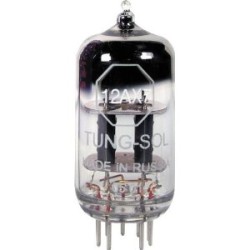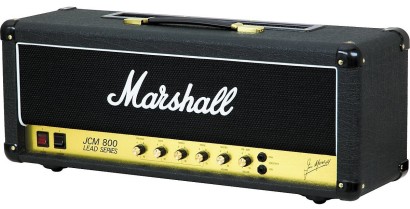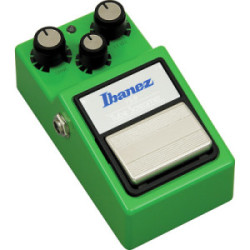This is part 3 of a 4 part instructional series on how to get the best possible live tone.
Part 1 – Introduction & General Information
Part 2 – Your Guitar
Part 3 – Amplification and Effects
Part 4 – Live Sound at the Gig
Choosing an Amplifier
An amplifier is arguably one of the most import aspects of the signal chain. What’s right for one person may not work for another. You should choose an amp that’s suited for your own requirements.
We’re going to look at some of the different amps on the market today and what they’re suited for.
Solid-State or Tube?
Without getting too technical, tube amps produce a warmth that is very pleasing to the human ear. It’s no secret that tube amps can go a long way in making you sound and perform at your best. It’s where the bulk of your tone is based, so you should also be prepared to spend a bit more money in this area. Although this conclusion is subjective, my opinion is based on myself as well as the vast majority of professional guitar players.

Tubes make your tone warmer and more natural.
Solid-state amplifiers are known to sound harsh at high volumes, making tube amps the better choice for live scenarios (at this point in time). Simulation, however, is becoming increasingly popular for gigging purposes. Processors such as the Line 6 POD and Axe-FX can accurately simulate the sound of desirable tube amps. You can read more about this in the following article: Using Amp Simulation Live On Stage.
British or American?
Tube amp enthusiasts usually reference these 2 terms.
A British sound is associated with Marshal amplification, while an American sound is associated with Fender and Mesa Boogie amplification.
Generally, British amplification uses EL34 or EL84 tubes while American amps use 6L6’s.
From a tone perspective, British amps produce more of a midrange type of sound, while American amps produce a scooped sound. The one is not better than the other, but you need to determine which one you like and want to use for your own needs.
Clean or Distortion?
Will you be using a clean or distorted sound, or both? If you’re only interested in using a clean sound (for example, if you play Jazz) then you may want to consider using an amp that specializes only in clean tones, such as the Roland Jazz Chorus 120 or Fender Twin Reverb.
On the other hand, if you’re looking for an overdriven rock sound, a tube amp will really shine. Most tube amps include 1 or more channels, which allow you to switch between a clean and overdriven sound.
Overdrive Pedal or Amplifier Drive Channel?
The general consensus amongst professional guitar players is that the drive channel on a tube amplifier is the way to go in terms of getting the best high gain sounds. This is also why amp simulators base their drive presets around popular tube amps.
There are, however, some great sounding distortion pedals on the market today. Personally I use a distortion pedal when I wanted to achieve tone at lower volumes. It can also be used to boost the drive channel on a tube amp (but more on that later).
Amp Size
Bigger is not always better.
Amp size is discussed in this article: Choosing the Right Amp Size for the Gig.
Rig Types
This is a rough indication of what amplification you will need based on the type of music you’ll be playing. Keep in mind that these amps fit all types and styles of music. Tone is very subjective, however the following comparisons are made based on well-known artists that use each amp type associated with the specified genre.
| Jazz | Country |
Blues | Rock | Heavy Metal |
|
| Marshal JCM800 |
✓ | ✓ | ✓ | ||
|
Fender |
✓ | ✓ | |||
| Fender Hotrod Deluxe |
✓ | ✓ | |||
| Mesa Boogie Dual Rectifier |
✓ | ✓ | |||
| Soldano SLO-100 |
✓ | ✓ | ✓ |
Dialing in Your Tone: Idea 1 of 3
Amplifier settings play an import role in crafting your tone. These are the bass, middle and treble settings. Not only do they play a part in defining your tone and response from your instrument, but they also play a role in setting your amp accordingly for a full band scenario. Amplifier settings don’t, however, change the fundamental sound of the amp.
Because amplifiers have a general sound regardless of the settings, the first idea to dialing in your tone is to find the type of sound you want to make use of. The idea is to find an artist you like (generally your favorite guitar player) and look at what gear they’re using in order to achieve their sound.
We can refer to this as our reference tone. You will then need to match your personal setup with similar gear.
Another great way to experiment with different amplifier types, stomp boxes and effects is to use an amp simulator. There are popular software based options such as Amplitube, which allow you to plug your guitar into your PC and achieve almost any sound possible.
Dialing in Your Tone: Idea 2 of 3
You can use this method to make the sound of your amp really come to life and make your guitar very responsive. It involves setting your amp to a completely flat response. It’s also my favorite method for dialing in an amp.
All you have to do is treat each control on a tube amp as having an obvious sweet spot. This is the area where the control goes from doing virtually nothing to making a strong impact on your sound.
Start by turning each control to 0. Slowly turn each control up until you hear the obvious point where it makes an impact on the sound. There is where the control should be set.
There is no particular order in which you should dial in your controls, however you may want to start with your bass control, because it will be the easiest to hear.
I also like to dial in my amp settings when my neck pickup on my guitar is selected.
This technique also works for pedals.
Dialing in Your Tone: Idea 3 of 3
- Always set your tone in context of a mix. If you’re dialing in your sound at home, play a song or backing track through a Hi-Fi system and adjust your amp to complement the mix.
- Use more mids. If you’re struggling to hear yourself, increasing the mids will help you to cut the mix. Keep in mind that guitar is, in fact, a midrange instrument;
- Play softer. You want to avoid playing at a level that’s uncomfortable for your listeners.

The Marshal JCM800 is one of the most popular hi-gain amps that sounds great for both live and studio use.
Playing in Stereo
Effects such as delay and chorus can sound great when used in a stereo (2 amp) configuration. Many famous players use a stereo rig for live. John Petrucci (Dream Theater) suggests that all players use a stereo configuration because of the obvious benefits in tone.
Here’s a quote from Mark Robinson that appeared on TheGearPage.net:
“There is a magic synergy that happens when you lash up a significant amount of radiating area and you have everything in phase and purring. The natural sustain, even clean, and the pressure you can get with some gain is fantastic. The guitar becomes an applicator for this pressured energy stream, and it’s addictive. “
Is a stereo configuration right for you? Take a look at this article: Should You Play Guitar In Stereo at a Gig?
Your Lead Sound
You may want to have a slightly altered tone for your lead guitar parts as opposed to rhythm parts. This is also my preference, however it comes down to your personal tastes.
Tube amplifiers will often feature a lead channel in addition to a clean and crunch channel. This will allow you to achieve more gain, and if necessary, more volume. On the topic of volume, you want to make sure that your lead solos are not buried in the mix. It’s the FOH sound engineers responsibility to boost your guitars volume on solo parts, however depending on the expertise on the engineer this isn’t always the case.
In order to boost your lead channel, it should have a bump in midrange instead of volume (if possible).
Mid Boost
The Ibanez Tube Screamer (TS9) is a popular mid boost pedal that countless of other pedals have been based upon. This is a great pedal to engage during solo parts for added volume and gain, as well as a more cutting sound. It can be used in conjunction with the drive channel on a tube amp to achieve this.
Effects
If you’re interested in adding specific effects to your sound, take a look at this article for tips on ordering your signal chain: How to Arrange the Order of Your Effects Pedals.
Effects can be used for enhancing your tone when used correctly and at the right times.
My advice is to only use an effect if you have a clear picture in mind of what sound you want to achieve from it. A basic sound consists of clean and overdrive, which you should become familiar with in a musical context before you begin to apply effects.
Delay/Reverb
Reverb and delay are common in guitar rigs because they add atmosphere and make your tone fatter. I always use delay when playing live, because I like a sound that’s slightly wet. But again, this comes down to personal preference.
If you’re using distortion on the drive channel of a tube amplifier, make sure that you use your effects loop to add delay/reverb to your chain. The delay effect needs to be present after the distortion, so if you’re running a pedal into the front of an amp, you won’t accomplish this.

You also want to make sure that you use an effects processor that can run at +4dB. Guitar pedals run at –10dB, so generally they won’t work in an effects loop. There are many time based effects processors suitable for guitar amplifiers like the TC Electronic G-Major.
Take a look at this article for further reading: How to Add Delay to Your Signal Path.
Cables
Did you know that using a different cable can alter your tone? You may want to experiment with different cables to see what effect they have on your tone and you can also decide which one you like best. You also want to avoid using extremely long cables as they can cause high end loss.
My recommendation is that you don’t spend too much money on cables for live gigs: Why You Should Avoid Expensive Gear. In a recording studio, you should use a high quality cable, as every aspect of your signal chain is always important.

